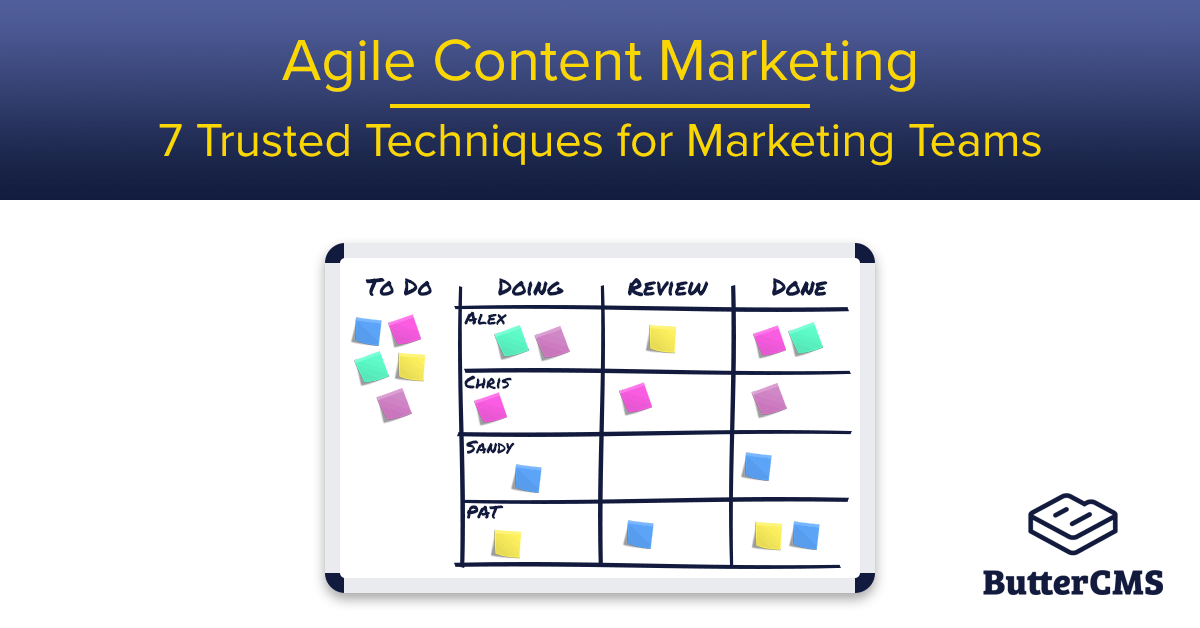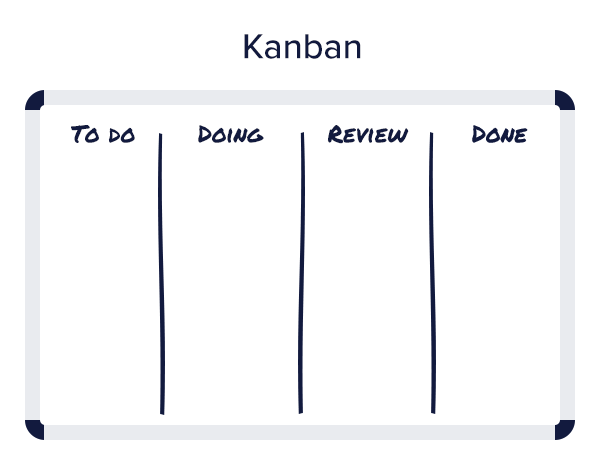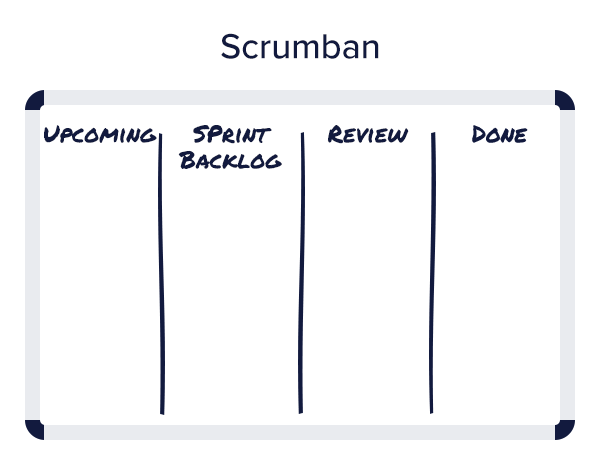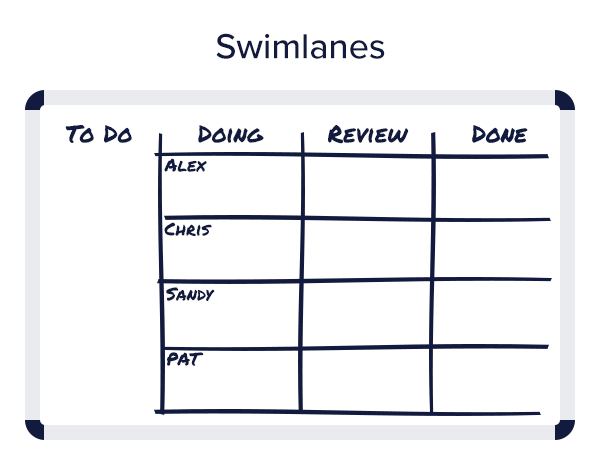Content marketing is always evolving. Agile content development is one way you can keep up.
Changes like new channels, new competitors showing up on the scene, and even huge shifts in the market will always keep you and your content team on your toes.
Sticking to how you’ve always developed content is probably not going to work. You have to adapt quickly.
Until recently, there was no way for marketing teams to be this flexible. However, marketers eventually found a solution by adopting the agile methodology used by software development teams, and updating marketing tech stacks to match.

According to the 2020 Annual State of Agile Marketing Report, as many as 58% of agile marketers reported higher productivity levels. 54% enhanced their ability to adapt to changing priorities and 44% accelerated delivering on campaigns.
Although the benefits are obvious, implementing agile can get quite confusing. So in this post, we’ll be walking you through the best practices for agile content development that will sharpen and improve your content development process.
But before we get started, it’s important to understand what agile marketing is.

What Is Agile Content Marketing?
Agile content marketing is the adoption, modification, and application of agile values and processes to content marketing.
Agile marketing teams have an edge over traditional marketing teams as they can adapt quickly to market changes and produce campaigns at a faster pace. Agile teams experiment a lot, adopt what works and improve on it. They can also focus on high-value projects helping them to avoid taking on too much work at once. This is a notable game-changer for small businesses content marketing.
An added benefit is that agile content teams review and improve on campaigns quickly and have better collaboration among team members than traditional marketing teams.
7 Best Practices for Implementing Agile Content Development
Based on data we gathered from the State of Agile Marketing Report, here are 7 best practices to improve agile content creation.
1. Use Customer Stories
A lot of times, content teams create without paying close attention to their audience’s pain points. Content like this is not helpful to the audience and will most likely get ignored.
To avoid this and create content that customers need, agile marketing teams use customer stories.
Customer stories, or user stories, show marketing teams who they are creating for, what they are creating, and what value it creates.
Just in case you are wondering, customer stories are not long-winded. They are usually single sentences that give your marketing team direction and focus while developing content.
To create a customer story, marketers use this simple format:
“As a persona, I would like some kind of content so I can achieve an outcome.”

For example, the customer story for this blog post would read something like this:
"As a content marketer, I would like a blog post that explains agile marketing best practices so that I can create better content faster.”
You can add in more details if it will help you create better content for your customers. You can adapt this to what you need as there are no hard and fast rules.
2. Publish Content Frequently
An agile team frequently releases its content to its audience. They do not do this just to have a high publishing velocity but to get feedback, whether negative or positive.
As Leigh George, branding expert and founder of Freedom, a marketing agency, explains:
|
"The quicker you can get content out the door, the easier it is to discover patterns of what your customers like or dislike."
- Leigh George
|
Shipping content faster, testing what works, and acting on feedback requires shorter and smaller campaigns and working in sprints. These smaller campaigns released every 1-3 weeks look daunting when compared to the usual 6-8 month campaign release time.
But it is possible to publish content frequently without sacrificing quality.
A great example of this is Santander's 'Unlock You London’ campaign. Instead of one big campaign, the marketing team (in partnership with an agency) released a campaign weekly and evaluated it based on feedback. Using this feedback, they were able to focus on and scale successful campaigns. The unsuccessful ones were abandoned—saving the company valuable time and resources.

Image source
As you can see, frequent releases require you to focus on improving the quality of content and not just increasing publishing velocity.
3. Hold Daily Standups
In Agile content development, things move very fast. To keep the team focused and aligned on the same goals, marketers need to communicate openly and clearly. One of the ways agile teams do this is by having daily standups.
Daily standups go beyond standing and talking. According to Jason Yip, Agile coach at Spotify, these strategy sessions help teams share an understanding of goals, coordinate efforts, share problems and improvements and identify as a team.
Daily standups vary from team to team, as some teams meet for 15 minutes every day, while some other teams meet less frequently.
Whether daily or two or three times a week, standup meetings should be kept short and straight to the point. To keep the conversation on track and focused, Jason suggests teams answer three questions:
- What did I accomplish yesterday?
- What will I do today?
- What obstacles are impeding my progress?
These questions keep your team members updated on the progress of work, keep them aware of individual contributions, and help them figure out blockers.

4. Hold Retrospectives After Sprints
At the end of campaigns/sprints, agile teams meet to discuss three things:
- What went wrong
- What went right
- What they can do better next time
To keep the discussion on track, Andrea Fryer, co-founder of AgileSherpas, suggests teams use three rules:
- Retrospectives should involve only agile team members; No stakeholders or outside observers are allowed. While the Scrum Master can attend the meeting, the Product Owner and other management can not.
- Keep the discussion civil and positive. It should always focus on the process and not people. Avoid blaming team members for the shortcomings that occurred during the sprint.
- Focus on actionability. Make sure your team identifies issues that can be fixed and then assigns people to be responsible for fixing these problems.
Just like daily stand-up meetings, retrospectives provide a means for team members to communicate and improve on their work.
5. Set Work In Progress (WIP) Limits
Marketing teams often have several projects on their plates at the same time.
To ensure projects are completed on time and on budget, agile marketing teams use WIP limits. These limits force teams to eliminate multitasking and focus on getting smaller amounts of work done. By doing this, more content can be shipped faster.
Imagine you manage a small content team of 2 writers and an editor. Your team has a backlog of 10 articles. To get the project moving as fast as possible, you might decide to assign all the articles to the writers at the same time and give them a deadline of 2 weeks, and then ask them to send in the completed pieces for review by the editor. Several problems might rear their ugly heads at this point:
- The writers might rush through writing the pieces to meet the deadline.
- The writers might be forced to multitask and work on several tasks at once.
- The completed pieces might come in around the same time—swamping the editor with work.
- The articles might not pass through the editing process in time and nothing gets published.
However, using WIP limits would make you approach this differently. Let’s take a look at our content development process at ButterCMS.
Writers on our team are assigned topics from the backlog of approved articles. We limit the number of assigned articles to 1-2 pieces per writer keeping the tasks within an achievable limit. Instead of writers sending in articles when all are completed, they send each piece for review immediately when they are completed. In turn, the editor can start reviewing the pieces without them piling up, while the writers can move on to the next task. This way, content gets published faster without overwhelming the team.
WIP limits help you assign achievable tasks to team members within a given time frame, remove bottlenecks, and monitor progress until the entire target has been completed.
6. Visualise Workflow With a Kanban Board
Developing content in an agile way means there are a lot of parts moving all at once. Marketers use Kanban boards to keep track of what’s going on, identify and get rid of bottlenecks, and improve on work.
Due to the unique challenges marketing presents, marketing teams have modified Kanban boards to suit their needs. You can select any type to suit your team’s needs as well.
You can begin with a simple Kanban board consisting of four columns, or stages, that show the various stages content passes through before publication.

If you are taking a hybrid approach to content, the Scrumban board might serve you better. You can keep track of upcoming work your team is yet to start, monitor backlog and work as it progresses, and review completed work.

Using a Kanban board is also a useful tool for teams with individuals working on different projects.
Each team member has tasks in their column and individual progress can be tracked and monitored.

7. Build Your Marketing Tech Stack
Kanban boards are not the only weapons in an agile content team’s arsenal.
A marketing team needs various tools to produce and publish content in an agile way. There are a lot of tools to choose from. These are a few that should form the foundation of your marketing tech stack:
- A visual task management board like Trello or Asana to make work visible and transparent as it progresses.
- A collaborative work tool like Slack or Basecamp helps agile marketing teams communicate openly and clearly.
- A headless CMS (content management system) like ButterCMS that integrates easily with new or existing web projects with in-app features to help you create relevant and useful content faster.
- A digital asset management tool like Adobe Experience Manager Assets to store, organize, and share digital assets (some headless CMS tools, like ButterCMS, include asset management).
- A campaign tracking tool like Hubspot or Drip to plan, execute, track and analyze marketing campaigns.
Choosing the right tool can be hard, so here are some useful pointers from Agile Sparks.
- An agile tool should talk in marketers’ language and not force marketers to learn the language of development/IT.
- It should be flexible. Marketers are not following Scrum to the letter. It should enable marketers to follow lean/agile principles without forcing the wrong practices.
- It should allow different teams in the organization to easily adapt their area in the tool to support their own process.
- It should emphasize simplicity, ease of use, and streamlined flows. It should integrate easily with other modern marketing tools.
- It should provide some actionable insights.
Conclusion
The best practices we have outlined above will help you learn quickly what works and doesn't work while improving your results and processes. However, these best practices came about because marketing teams adopted and modified agile values and principles to get their work done in a better way. They experimented a lot, learned from feedback, and improved on what worked.
In the same way, you shouldn’t be afraid of adopting these practices and changing them to suit the needs of your team. In doing so, you can incrementally improve your marketing efforts.
A great place to start is a headless CMS tool like ButterCMS. If you're ready to stop scrambling between different martech tools, you can use Butter to start managing all your content for all your channels with one central dashboard today. To see how Butter has helped other companies take control of their content, check out our customer stories.
Do you want your product or marketing team to test Butter CMS? We can set up a live demo to walk your team through the fast, easy-to-use interface.









